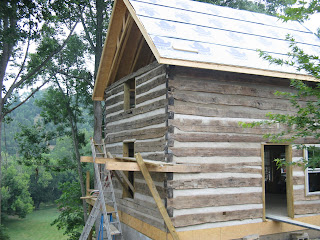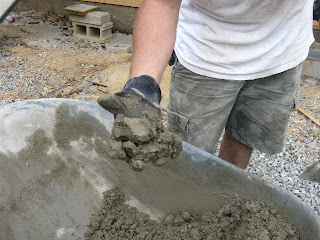





 Chink -(chngk) intransitive verb. 1. To make narrow openings in.
Chink -(chngk) intransitive verb. 1. To make narrow openings in.2. To fill narrow openings in. 3. Slang. coin or ready cash.
Ready Cash? Readily leaving our pockets is more like it! In the grand scheme of things, I sometimes think "It's only money" and then I think about the alternative. You've heard "You can't take it with you", haven't you. Well........what if you can? Wouldn't you feel kinda silly when you arrive at the Pearly Gates and St. Peter asks.."Where's your stuff"? I don't know, but it gives me something else to think about while the chink, chink sound is pouring out of our pockets.
This past week was chinking week here at the loghouse project. Chinking is my favorite part of this project. It not only shows the character of the house, but it defines its charm. When we took the house apart several years ago, it had no chinking at all, just slats of wood jammed into the chink joints. The logs were covered in red oak planking, about 1 1/2" think and about 8" wide, on top of the red oak was years and years of wallpaper. When we took down the old McConnell house, the chink joints were filled with mud and horsehair with chits of wood.
The chinking we put in this week is made of sand, brixment N and S type mortar. I worked with Andrew to understand how this stuff is mixed. It's very important to mix all the dry ingredients together, much like mixing ingredients for a cake. Mixing is not just mixing, it's chopped using a hoe. This kind like hoeing out a corn row. Once it's chopped, then mixed again, just add water. Water is the real trick, you can't add too much or it's soupy, too little and it crumbles and won't stick to the wire mesh. When you clump it in your hand, it doesn't all stick together, but it doesn't exactly fall apart either. It's one of those tacit things you learn by doing over and over again to get it right. That is if you don't have a Tony Russell around to show you how it's done.
The mortar is put in with a small trowel in the chinking joints. Tony and Mark are experts at this and it's amazing to watch them work. They each have different techniques putting the mortar in but with the same result. Once the mortar is dried for a few minutes, they use wet gloves to smooth out the mortar and give it the shape it has. The mortar has to be sloped downward (concave) to allow rain to run off. It was so hot this week, it didn't take long for the mortar to dry out quickly.
So, now that the chinking is in on the outside, we'll starting cleaning out the joints on the inside and put GreatStuff along the top, bottom and sides of each joint to stop any airflow. I don't know what we did before Great Stuff came along. The Great Stuff we used 20 years ago isn't the same stuff we have today. 20 years ago it was a formaldehyde based. What we use today is silicone and doesn't deteriorate as quickly. Case in point,this summer we power washed the logs from outside. It took 2 days for the logs to dry out in the inside. At least the logs are clean inside and out.
Doug and Lee are back this week working on the stairs and closing in the gable ends, putting in the windows and board and batten. More on this progress later.
Have a great week!
Come around when you can.
Talk to you soon
Talk to you soon
NoraBelle
No comments:
Post a Comment
Note: Only a member of this blog may post a comment.